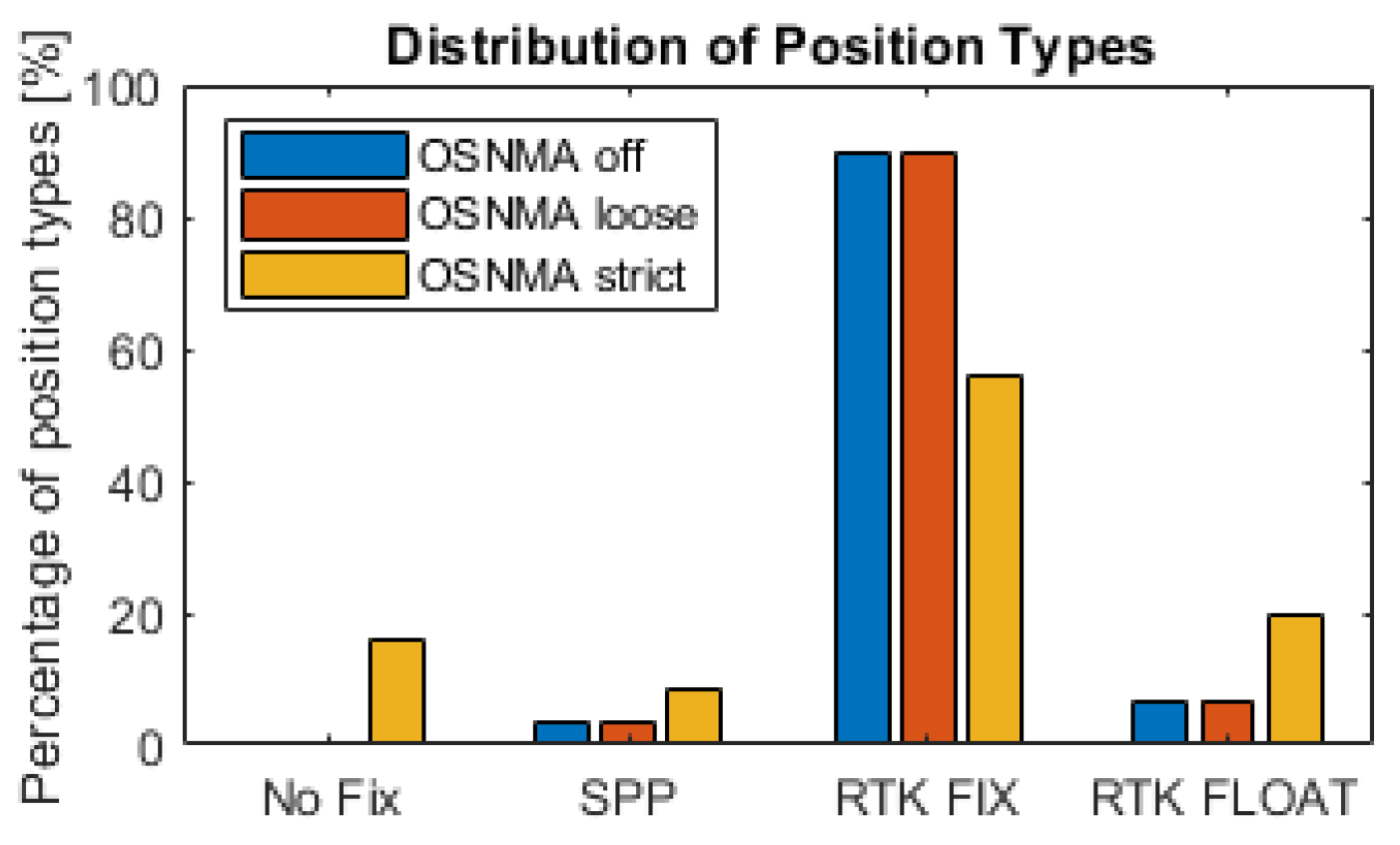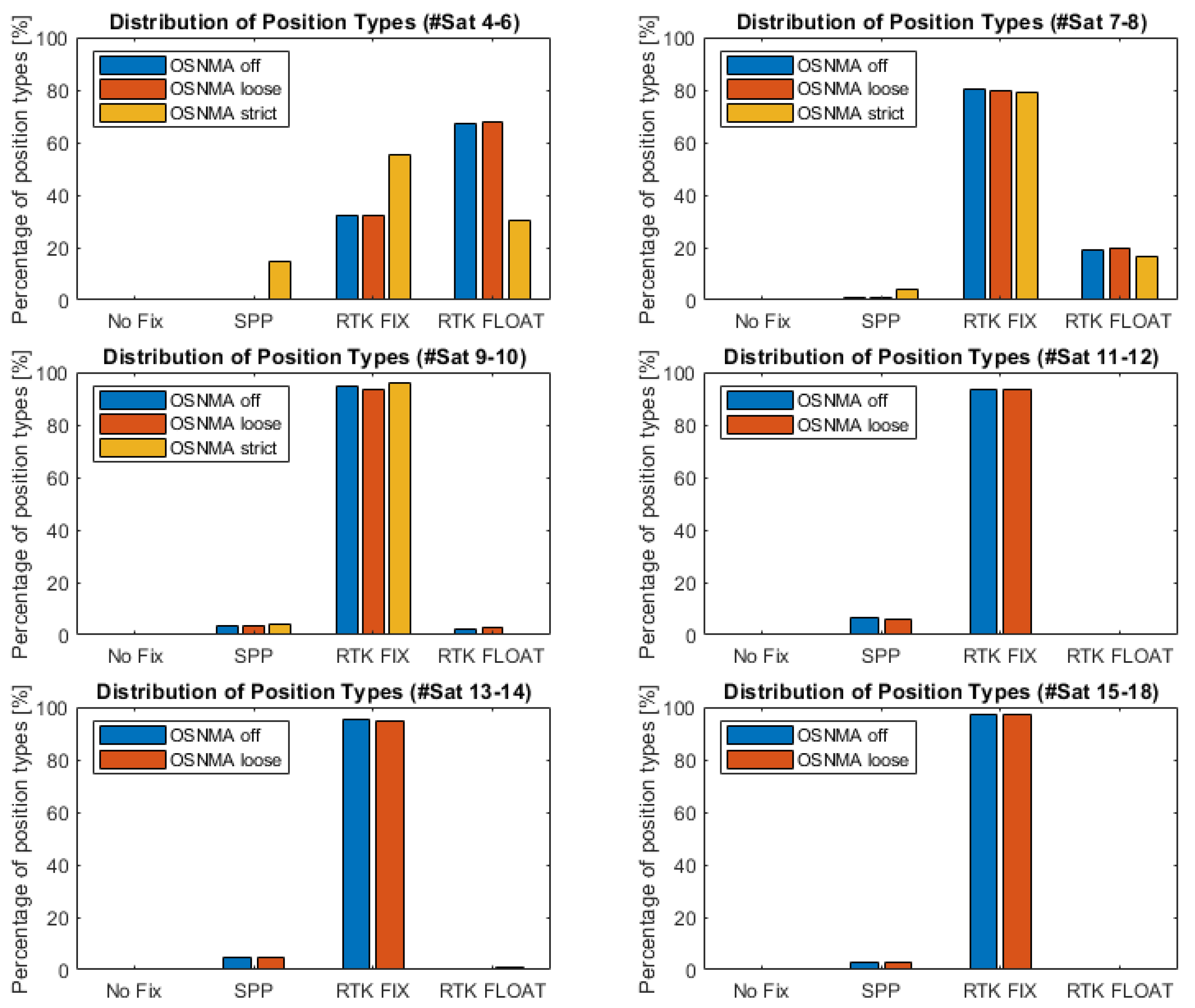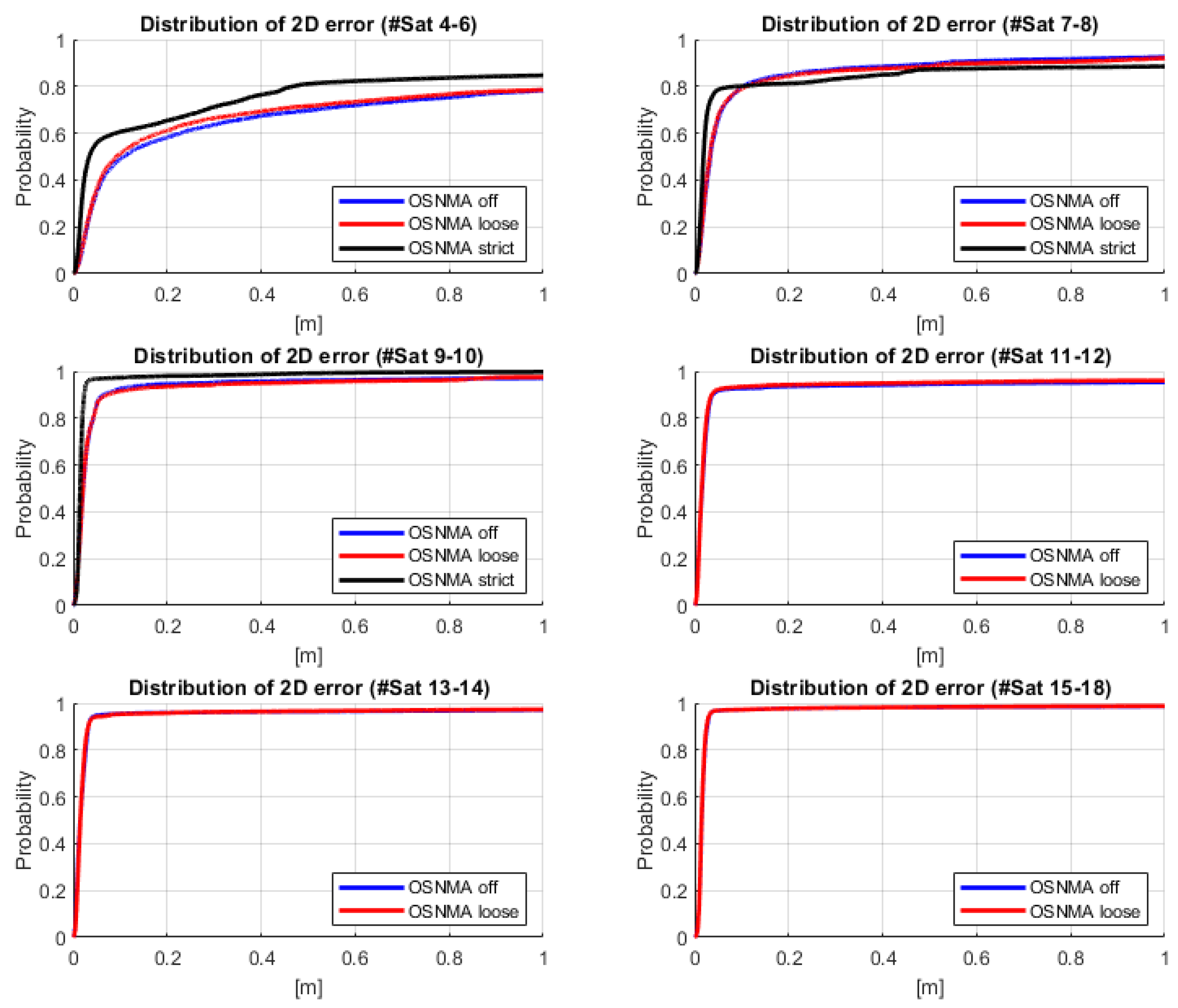A Comparative Experimental Performance Assessment of RTK+OSNMA-Based Positioning for Road Vehicle Applications †
Abstract
:1. Introduction
2. Experimental Settings
3. Results and Discussion
4. Conclusions
Author Contributions
Funding
Institutional Review Board Statement
Informed Consent Statement
Data Availability Statement
Acknowledgments
Conflicts of Interest
References
- Petovello, M.; O’Driscoll, C. What Is Navigation Message Authentication? Inside GNSS Magazine. January/February 2018, pp. 26–31. Available online: https://insidegnss-com.exactdn.com/wp-content/uploads/2018/04/janfeb18-SOLUTIONS.pdf (accessed on 15 May 2023).
- Fernández-Hernández, I.; Rijmen, V.; Seco-Granados, G.; Simon, J.; Rodríguez, I.; David Calle, J. A Navigation Message Authentication Proposal for the Galileo Open Service. J. Inst. Navig. 2016, 63, 85–102. [Google Scholar] [CrossRef]
- ESRIUM Project Webpage: EGNSS-Enabled Smart Road Infrastructure Usage and Maintenance for Increased Energy Efficiency and Safety on European Road Networks. Available online: https://esrium.eu/ (accessed on 15 May 2023).
- Rudigier, M.; Nestlinger, G.; Tong, K.; Solmaz, S. Development and Verification of Infrastructure-Assisted Automated Driving Functions. Electronics 2021, 10, 2161. [Google Scholar] [CrossRef]
- Hammarberg, T.; Vallet García, J.M.; Alanko, J.N.; Bhuiyan, M.Z.H. FGI-OSNMA: An Open Source Implementation of Galileo’s Open Service Navigation Message Authentication. In Proceedings of the 36th International Technical Meeting of the Satellite Division of The Institute of Navigation (ION GNSS+ 2023), Denver, CO, USA, 11–15 September 2023; pp. 3774–3785. [Google Scholar] [CrossRef]
- Galan, A.; Fernandez-Hernandez, I.; Cucchi, L.; Seco-Granados, G. OSNMAlib: An Open Python Library for Galileo OSNMA. In Proceedings of the 2022 10th Workshop on Satellite Navigation Technology (NAVITEC), Noordwijk, The Netherlands, 5–7 April 2022; pp. 1–12. [Google Scholar] [CrossRef]
- Galileo-Osnma. Available online: https://github.com/daniestevez/galileo-osnma (accessed on 15 May 2023).
- Septentrio. Release Notes and Installation Guide, Mosaic-X5 Firmware Package v4.12.1. 2023. Available online: https://www.septentrio.com/system/files/support/Mosaic-x5_firmware_v4.12.1_release_notes.pdf (accessed on 15 May 2023).
- Fernández-Hernández, I.; Ashur, T.; Rijmen, V.; Sarto, C.; Cancela, S.; Calle, D. Toward an Operational Navigation Message Authentication Service: Proposal and Justification of Additional OSNMA Protocol Features. In Proceedings of the 2019 European Navigation Conference (ENC), Warsaw, Poland, 9–12 April 2019; pp. 1–6. [Google Scholar] [CrossRef]
- Margaria, D.; Marucco, G.; Nicola, M. A first-of-a-kind spoofing detection demonstrator exploiting future Galileo E1 OS authentication. In Proceedings of the 2016 IEEE/ION Position, Location and Navigation Symposium (PLANS), Savannah, GA, USA, 11–14 April 2016; pp. 442–450. [Google Scholar] [CrossRef]
- Motella, B.; Nicola, M.; Damy, S. Enhanced GNSS Authentication Based on the Joint CHIMERA/OSNMA Scheme. IEEE Access 2021, 9, 121570–121582. [Google Scholar] [CrossRef]
- Motallebighomi, M.; Sathaye, H.; Singh, M.; Ranganathan, A. Cryptography Is Not Enough: Relay Attacks on Authenticated GNSS Signals. arXiv 2022, arXiv:2204.11641. [Google Scholar] [CrossRef]
- O’Driscoll, C.; Fernández-Hernández, I. Mapping Bit to Symbol Unpredictability in Convolutionally Encoded Messages with Checksums, with Application to Galileo OSNMA. In Proceedings of the 33rd International Technical Meeting of the Satellite Division of The Institute of Navigation (ION GNSS+ 2020), Online, 22–25 September 2020; pp. 3751–3765. [Google Scholar] [CrossRef]
- Nicola, M.; Motella, B.; Pini, M.; Falletti, E. Galileo OSNMA Public Observation Phase: Signal Testing and Validation. IEEE Access 2022, 10, 27960–27969. [Google Scholar] [CrossRef]
- Gamba, M.T.; Nicola, M.; Motella, B. Computational Load Analysis of a Galileo OSNMA-Ready Receiver for ARM-Based Embedded Platforms. Sensors 2021, 21, 467. [Google Scholar] [CrossRef] [PubMed]
- Motella, B.; Gamba, M.T.; Nicola, M. A Real-time OSNMA-ready Software Receiver. In Proceedings of the 2020 International Technical Meeting of The Institute of Navigation, San Diego, CA, USA, 21–24 January 2020; pp. 979–991. [Google Scholar]
- Gamba, M.T.; Nicola, M.; Motella, B. Galileo OSNMA: An implementation for ARM-based embedded platforms. In Proceedings of the 2020 International Conference on Localization and GNSS (ICL-GNSS), Tampere, Finland, 2–4 June 2020; pp. 1–6. [Google Scholar] [CrossRef]
- Cucchi, L.; Damy, S.; Paonni, M.; Nicola, M.; Gamba, M.T.; Motella, B.; Fernandez-Hernandez, I. Assessing Galileo OSNMA Under Different User Environments by Means of a Multi-Purpose Test Bench, Including a Software-defined GNSS Receiver. In Proceedings of the 34th International Technical Meeting of the Satellite Division of The Institute of Navigation (ION GNSS+ 2021), St. Louis, MO, USA, 20–24 September 2021; pp. 3653–3667. [Google Scholar] [CrossRef]
- Sarto, C.; Pozzobon, O.; Fantinato, S.; Montagner, S.; Fernández-Hernández, I.; Simon, J.; Calle, J.D.; Díaz, S.C.; Walker, P.; Burkey, D.; et al. Implementation and Testing of OSNMA for Galileo. In Proceedings of the 30th International Technical Meeting of the Satellite Division of The Institute of Navigation (ION GNSS+ 2017), Portland, Oregon, USA, 25–29 September 2017; pp. 1508–1519. [Google Scholar] [CrossRef]
- Cucchi, L.; Damy, S.; Paonni, M.; Nicola, M.; Motella, B. Receiver Testing for the Galileo E1 OSNMA and I/NAV Improvements. In Proceedings of the 35th International Technical Meeting of the Satellite Division of The Institute of Navigation (ION GNSS+ 2022), Denver, Colorado, USA, 19–23 September 2022; pp. 808–819. [Google Scholar] [CrossRef]
- Damy, S.; Cucchi, L.; Paonni, M. Impact of OSNMA Configurations, Operations and User’s Strategies on Receiver Performances. In Proceedings of the 35th International Technical Meeting of the Satellite Division of The Institute of Navigation (ION GNSS+ 2022), Denver, Colorado, USA, 19–23 September 2022; pp. 820–827. [Google Scholar] [CrossRef]
- Cancela, S.; Calle, J.D.; Fernández-Hernández, I. “CPU Consumption Analysis of TESLA-based Navigation Message Authentication. In Proceedings of the 2019 European Navigation Conference (ENC), Warsaw, Poland, 9–12 April 2019; pp. 1–6. [Google Scholar] [CrossRef]
- Seco-Granados, G.; Gómez-Casco, D.; López-Salcedo, J.A.; Fernández-Hernández, I. Detection of replay attacks to GNSS based on partial correlations and authentication data unpredictability. GPS Solut. 2021, 25, 33. [Google Scholar] [CrossRef]
- Cancela, S.; Navarro, J.; Calle, D.; Reithmaier, T.; Chiara, A.D.; Broi, G.D.; Fernández-Hernández, I.; Seco-Granados, G.; Simón, J. Field Testing of GNSS User Protection Techniques. In Proceedings of the 32nd International Technical Meeting of the Satellite Division of The Institute of Navigation (ION GNSS+ 2019), Miami, FL, USA, 16–20 September 2019; pp. 1824–1840. [Google Scholar] [CrossRef]
- Štern, A.; Kos, A. Positioning Performance Assessment of Geodetic, Automotive, and Smartphone GNSS Receivers in Standardized Road Scenarios. IEEE Access 2018, 6, 41410–41428. [Google Scholar] [CrossRef]
- Hammarberg, T.; Vallet García, J.M.; Alanko, J.N.; Bhuiyan, M.Z.H. An Experimental Performance Assessment of Galileo OSNMA. In Proceedings of the International Conference on Localisation and GNSS (ICL-GNSS 2023), Castellon, Spain, 6–8 June 2023. [Google Scholar]
- More Precise Positioning Needed for Vehicle Autonomy. Available online: https://insidegnss.com/more-precise-positioning-needed-for-vehicle-autonomy/ (accessed on 15 May 2023).
- Dai, M.; Li, H.; Liang, J.; Zhang, C.; Pan, X.; Tian, Y.; Cao, J.; Wang, Y. Lane Level Positioning Method for Unmanned Driving Based on Inertial System and Vector Map Information Fusion Applicable to GNSS Denied Environments. Drones 2023, 7, 239. [Google Scholar] [CrossRef]
- Du, J.; Masters, J.; Barth, M. Lane-level positioning for in-vehicle navigation and automated vehicle location (AVL) systems. In Proceedings of the 7th International IEEE Conference on Intelligent Transportation Systems (IEEE Cat. No.04TH8749), Washington, WA, USA, 3–6 October 2004; pp. 35–40. [Google Scholar] [CrossRef]








Disclaimer/Publisher’s Note: The statements, opinions and data contained in all publications are solely those of the individual author(s) and contributor(s) and not of MDPI and/or the editor(s). MDPI and/or the editor(s) disclaim responsibility for any injury to people or property resulting from any ideas, methods, instructions or products referred to in the content. |
© 2023 by the authors. Licensee MDPI, Basel, Switzerland. This article is an open access article distributed under the terms and conditions of the Creative Commons Attribution (CC BY) license (https://creativecommons.org/licenses/by/4.0/).
Share and Cite
Lesjak, R.; Schweitzer, S.; Vallet García, J.M.; Diengsleder-Lambauer, K.; Solmaz, S. A Comparative Experimental Performance Assessment of RTK+OSNMA-Based Positioning for Road Vehicle Applications. Eng. Proc. 2023, 54, 45. https://doi.org/10.3390/ENC2023-15434
Lesjak R, Schweitzer S, Vallet García JM, Diengsleder-Lambauer K, Solmaz S. A Comparative Experimental Performance Assessment of RTK+OSNMA-Based Positioning for Road Vehicle Applications. Engineering Proceedings. 2023; 54(1):45. https://doi.org/10.3390/ENC2023-15434
Chicago/Turabian StyleLesjak, Roman, Susanne Schweitzer, José M. Vallet García, Karl Diengsleder-Lambauer, and Selim Solmaz. 2023. "A Comparative Experimental Performance Assessment of RTK+OSNMA-Based Positioning for Road Vehicle Applications" Engineering Proceedings 54, no. 1: 45. https://doi.org/10.3390/ENC2023-15434
APA StyleLesjak, R., Schweitzer, S., Vallet García, J. M., Diengsleder-Lambauer, K., & Solmaz, S. (2023). A Comparative Experimental Performance Assessment of RTK+OSNMA-Based Positioning for Road Vehicle Applications. Engineering Proceedings, 54(1), 45. https://doi.org/10.3390/ENC2023-15434






